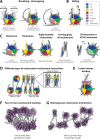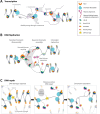Always on the Move: Overview on Chromatin Dynamics within Nuclear Processes
- PMID: 40312022
- PMCID: PMC12096440
- DOI: 10.1021/acs.biochem.5c00114
Always on the Move: Overview on Chromatin Dynamics within Nuclear Processes
Abstract
Our genome is organized into chromatin, a dynamic and modular structure made of nucleosomes. Chromatin organization controls access to the DNA sequence, playing a fundamental role in cell identity and function. How nucleosomes enable these processes is an active area of study. In this review, we provide an overview of chromatin dynamics, its properties, mechanisms, and functions. We highlight the diverse ways by which chromatin dynamics is controlled during transcription, DNA replication, and repair. Recent technological developments have promoted discoveries in this area, to which we provide an outlook on future research directions.
Keywords: DNA sequence; chromatin dynamics; chromatin organization; nucleosome.
Copyright © 2025 The Authors. Published by American Chemical Society. This publication is licensed under CC-BY-NC-ND 4.0.
Conflict of interest statement
The authors declare no competing financial interest.
Figures



Similar articles
-
Mechanisms of Nucleosome Dynamics In Vivo.Cold Spring Harb Perspect Med. 2016 Sep 1;6(9):a026666. doi: 10.1101/cshperspect.a026666. Cold Spring Harb Perspect Med. 2016. PMID: 27503998 Free PMC article. Review.
-
An Overview of Chromatin-Regulating Proteins in Cells.Curr Protein Pept Sci. 2016;17(5):401-10. doi: 10.2174/1389203717666160122120310. Curr Protein Pept Sci. 2016. PMID: 26796306 Free PMC article. Review.
-
Maintenance and dynamic reprogramming of chromatin organization during development.Plant J. 2024 May;118(3):657-670. doi: 10.1111/tpj.16119. Epub 2023 Feb 17. Plant J. 2024. PMID: 36700345 Review.
-
Chromatin Replication and Histone Dynamics.Adv Exp Med Biol. 2017;1042:311-333. doi: 10.1007/978-981-10-6955-0_15. Adv Exp Med Biol. 2017. PMID: 29357065 Review.
-
Nucleosome dynamics.Biochem Soc Symp. 2006;(73):109-19. doi: 10.1042/bss0730109. Biochem Soc Symp. 2006. PMID: 16626292 Review.
References
Publication types
MeSH terms
Substances
LinkOut - more resources
Full Text Sources

